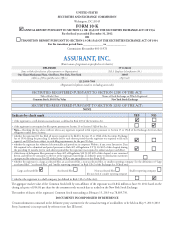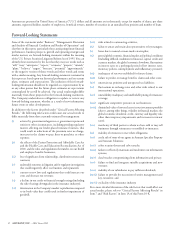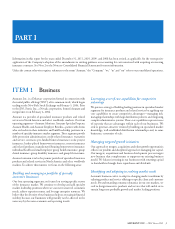Assurant 2012 Annual Report Download - page 19
Download and view the complete annual report
Please find page 19 of the 2012 Assurant annual report below. You can navigate through the pages in the report by either clicking on the pages listed below, or by using the keyword search tool below to find specific information within the annual report.ASSURANT, INC.2012 Form10-K 11
PARTI
ITEM 1 Business
U.S. Insurance Regulation
We are subject to the insurance holding company laws in the states
where our insurance companies are domiciled. ese laws generally
require insurance companies within the insurance holding company
system to register with the insurance departments of their respective
states of domicile and to furnish reports to such insurance departments
regarding capital structure, ownership, nancial condition, general
business operations and intercompany transactions. ese laws also
require that transactions between a liated companies be fair and
equitable. In addition, certain intercompany transactions, changes of
control, certain dividend payments and transfers of assets between the
companies within the holding company system are subject to prior
notice to, or approval by, state regulatory authorities.
Like all U.S. insurance companies, our insurance subsidiaries are subject
to regulation and supervision in the jurisdictions in which they do
business. In general, this regulation is designed to protect the interests
of policyholders, and not necessarily the interests of shareholders and
other investors. To that end, the laws of the various states and other
jurisdictions establish insurance departments with broad powers with
respect to such things as:
•licensing and authorizing companies and intermediaries (including
agents and brokers) to transact business;
•regulating capital, surplus and dividend requirements;
•regulating underwriting limitations;
•
regulating companies’ ability to enter and exit markets or to provide,
terminate or cancel certain coverages;
•
imposing statutory accounting and annual statement disclosure
requirements;
•
regulating product types and approving policy forms and mandating
certain insurance bene ts;
•
regulating premium rates, including the ability to disapprove or
reduce the premium rates companies may charge;
•
regulating claims practices, including the ability to require companies
to pay claims on terms other than those mandated by underlying
policy contracts;
•regulating certain transactions between a liates;
•regulating the form and content of disclosures to consumers;
•regulating the type, amounts and valuation of investments;
•mandating annual tests to analyze adequacy of reserves;
•
mandating assessments or other surcharges for guaranty funds and
the ability to recover such assessments in the future through premium
increases; and
•
regulating market conduct and sales practices of insurers and agents.
Dividend Payment Limitations
Our holding company’s assets consist primarily of the capital stock
of our subsidiaries. Accordingly, our holding company’s future cash
ows depend upon the availability of dividends and other statutorily
permissible payments from our subsidiaries. e ability to pay such
dividends and to make such other payments is regulated by the states
in which our subsidiaries are domiciled. ese dividend regulations
vary from state to state and by type of insurance provided by the
applicable subsidiary, but generally require our insurance subsidiaries
to maintain minimum solvency requirements and limit the amount
of dividends these subsidiaries can pay to the holding company. For
more information, please see Item7, “Management’s Discussion and
Analysis of Financial Condition and Results of Operations—Liquidity
and Capital Resources—Regulatory Requirements.”
Risk Based Capital Requirements
In order to enhance the regulation of insurer solvency, the National
Association of Insurance Commissioners (“NAIC”) has established certain
risk-based capital standards applicable to life, health and property and
casualty insurers. Risk-based capital, which regulators use to assess the
su ciency of an insurer’s statutory capital, is calculated by applying
factors to various asset, premium, expense, liability and reserve items.
Factors are higher for items which in the NAIC’s view have greater
underlying risk. e NAIC periodically reviews the risk-based capital
formula and changes to the formula could occur in the future.
Investment Regulation
Insurance company investments must comply with applicable laws
and regulations that prescribe the kind, quality and concentration
of investments. ese regulations require diversi cation of insurance
company investment portfolios and limit the amount of investments
in certain asset categories.
Financial Reporting
Regulators closely monitor the nancial condition of licensed insurance
companies and our insurance subsidiaries are required to le periodic
nancial reports with insurance regulators. Moreover, states regulate
the form and content of these statutory nancial statements.
Products and Coverage
Insurance regulators have broad authority to regulate many aspects
of our products and services. For example, some jurisdictions require
insurers to provide coverage to persons who would not be considered
eligible insurance risks under standard underwriting criteria, dictating
the types of insurance and the level of coverage that must be provided
to such applicants. Additionally, certain non-insurance products and
services, such as service contracts, may be regulated by regulatory bodies
other than departments of insurance.
Pricing and Premium Rates
Nearly all states have insurance laws requiring insurers to le price
schedules and policy forms with the state’s regulatory authority. In many
cases, these price schedules and/or policy forms must be approved prior
to use, and state insurance departments have the power to disapprove
increases or require decreases in the premium rates we charge.
























